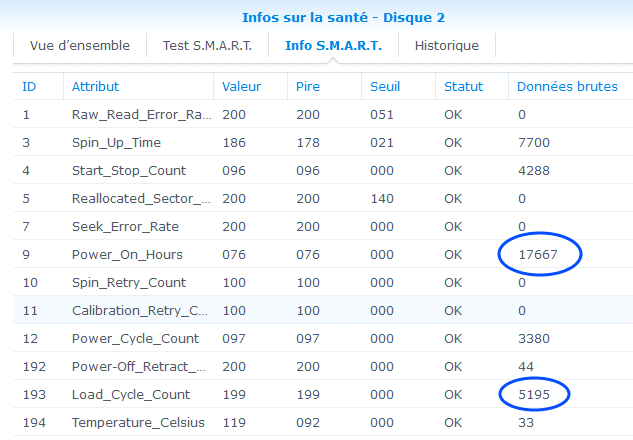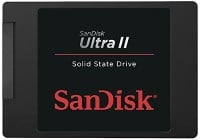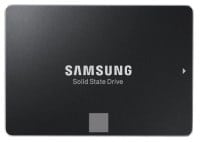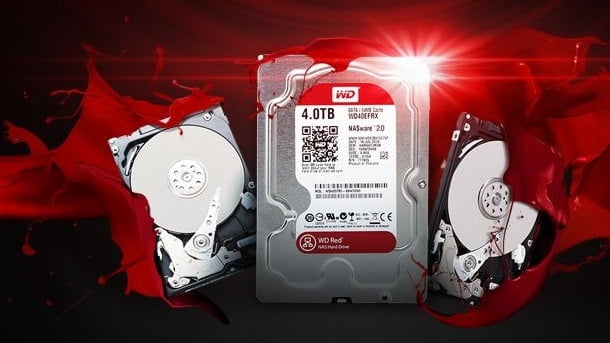Sommaire
Choosing a hard drive for your NAS can be difficult because, online, the opinion of each Internet user is based on their experience which can vary, and providing a RELIABLE survey is not always easy… at the same time, hard drive manufacturers have been on the market for some years now and propose RED hard drives designed specifically for NAS systems.
In any case, since a hard drive is a mechanical piece containing several platters that rotate, despite all the care given by manufacturers, failure can always occur!
Here are my recommendations:
- 2 hard drives in the RAID 1 setup to avoid a service cut with a NAS stopping in a hard drive failure
- opting for external replication of your data towards a server that you can rent, or save your data to the cloud (I invite you to read my tutorial)
Which type of RAID?
This depends on the criticality of your data, are you backing up your personal data (photos and videos) from your computer to the NAS or is it just a storage means that will allow you to simply stream your contents on your TV?
JBOD/Basic
If your NAS is used only to store videos or photos that you can retrieve elsewhere, or your NAS is already saved in another physical place, then the JBOD/Basic type is the most suitable one!
Every hard drive that you add increases the capacity, because the storage capacity adds up.
Thus, if you buy two 2TB drives, this will mean 4TB storage in total.
On the other hand, there is no data redundancy; in case of hard drive failure, either:
- you chose JBOD: the volume is no longer readable
- you chose Basic: you lose half of the storage and thus half of the data
If your NAS is saved in a remote location from your place and you can wait several hours to retrieve your data, these methods of storing are quite interesting and are also the cheapest ones, because the capacities add up.
SHR
By default, SHR is recommended for your Synology NAS and it is ideal for those people who don’t want to get into specifics, it’s perfect for beginners with no hassle.
It allows mixing disks of different sizes without loss of space, thus you can mix 1, 2 and 4TB drives, it is the SHR that distributes the data.
It also provides data redundancy according to your drives, and allows simple extension by adding drives if your NAS can support several disk drives.
RAID 1
Since my Synology NAS is equipped with 2 storage bays, I chose a RAID 1 type, where one disk drive is a mirror of the other (the same data is stored on each disk drive).
This is not cost-effective, since the storage spaces available do not add up, therefore with two 4TB disks, the total space will still be 4 TB.
On the other hand, this NAS contains all my photo & video data, and I did not want to lose everything in the event of a drive failure, because I have a tremendous amount of data and restoring everything online would take me a few days.
This allows to have good service quality, because in case of failure of a disk I can replace it, and the mirroring of the new disk is carried out on reboot (this may take several days), but I can always access my data.
Make sure that you use the same drive sizes, otherwise the smallest disk will determine the total storage size: one 2TB disk + one 4TB disk, with RAID 1, will mean that you’ll only have 2TB available and you will only use half of the 4TB disk!
RAID 5/6
For NASs equipped with 4 hard drives or more, RAID 5 is a good choice if you don’t want to lose too much disk space, because RAID 5 allows one disk failure, meaning that that disk does not count in the total capacity.
RAID 6 is even more expensive, because two drives can fail without resulting in data loss, therefore the total space is reduced by 2 hard drives, but on the other hand you maximize your chances of having a NAS that is still operational!
Why did I opt for Green hard drives instead of those created specifically for NAS (Red)?
When I started storing data on a Synology NAS, RED hard drives did not exist, so I had chosen Green hard drives since they have a lower rotation speed compared to disks with a rotation speed of 7,200 rpm and are thus quieter, and their price was lower than for non-green hard drives.
Consequently, and having a Synology NAS with 2 bays, I had assumed (and maybe I was wrong, but the probability of having 2 disks crashing at the same time is low) that I would put 2 Green hard drives in RAID 1 (data mirroring between the two disks) and thus, if one of the hard drives stopped working, then the one left would hold on until I got another disk.
Now that Green hard drives are no longer developed, my NAS is equipped with Red hard drives designed for NAS systems. The advantage is having a 3-year warranty instead of the conventional 2 years. That’s a good point.
To find out if the hard drive you’re interested in is compatible with your Synology NAS, I recommend their official guide.
Switching to hard drives for NAS
If we take a look at Western Digital or Seagate’s documentation, we note that hard drives have firmware suited for NAS and are designed to work around the clock.Thus, there are only 2 hard drive manufacturers designed for NAS. I’ve collected all the data based on the tests performed by Tom’s Hardware on 4TB disks for comparison:
| Western Digital RED NAS | Seagate IronWolf NAS | |
|---|---|---|
 |  | |
| Size | 4 TB | 4 TB |
| Rotation | 5400 RPM | 5900 RPM |
| Reading at peak write speed | 5.9 W | 6.5 W |
| Sequential Read Speed | 134 MB/s | 156 MB/s |
| Mixed speed | 119 MB/s | 129 MB/s |
| Temperature | 33° | 34° |
| Release date | 2013 | 2017 |
| Price | €€ | € |
| AMAZON | AMAZON |
The obvious choice is Seagate IronWolf NAS Hard Drive since it offers higher rotation speed, which stands for increasing performance and contained consumption, because it does not run at 7200 rpm.
Since IronWolf was released 2017, it is not surprising that it outperforms its competitor that has been around since 2013, plus… it’s cheaper!
Since sequential read speed is important, it is quite possible to watch several videos simultaneously without fear of disk saturation.
Specifics of other hard drives models (other than NAS)
If you don’t want to use hard drives developed for NAS systems, you have the possibility to install any type of hard drive.I recommend that you read my article on the 7 best NAS devices on the market.
Specifics of Western Digital hard drives
Western Digital’s hard drive family is composed of:
- Blue – designed for everyday users
- Black – For Max performance
- Purple – For surveillance. Mostly used for storing and recording videos. For example, in security systems
Specifics of Seagate hard drives
- Barracuda – designed for everyday use
- SkyHawk – designed for video surveillance
Testing Western Digital RED After-Sales Service (unplanned)
One of my current 4TB Western Digital hard drives generated a SMART warning that was brought to the surface by the NAS: it couldn’t be ignored, since the Synology NAS kept beeping and an orange light had appeared on the front.
Therefore, I sent the hard drive to the After-Sales Service and while I was waiting for its return, the other disk took over; thanks to RAID 1, I was able to continue using my NAS. Once it got back from the After-Sales Service, I put the new disk again, the data was automatically copied and all was over after a couple of days.
So apart from this trip to the After-Sales department, I’m very satisfied of Red NAS drives, and I’m going to show you the SMART reports (to generate them, go to Storage Manager> HDD/SSD> Health info) of the different hard drives:

2 significant numbers:
- Power_On_Hours: 17,667 operating hours, meaning almost 2 continuous years (my NAS is set to put the 2 disks on standby after 20 minutes)
- Load_Cycle_Count (LCC): 5,195, this is the number of load/unload cycles
Since the LCC is low, that’s perfect, or at least as long as this number does not exceed 300,000 (disks are no longer under warranty if they exceed that LCC level).
SSDs in NAS drive
There are many half-truths surrounding SSDs in NAS, and some old top-ranked articles in search engine results state that SSD drives are unreliable, that they are not suitable or underperforming… LET’S STOP THIS!
Not so long ago, it was even possible to read tutorials to disable all the benefits of SSDs, unbelievable! The aim of SSDs is to be particularly fast, therefore in no case should you handicap it by limiting it.
Especially when it comes to wear, since an SSD drive has a defined writing capacity, except that manufacturers apply a certain duration to their SSD warranty, for example 5 years for Samsung, or up to 75TB written (TBW), so that the warranty does not apply if my SSD gives a number over 75TB.

Here you can see the status of an SSD drive connected to a computer with Windows 10 after 1 year thanks to Samsung Magician, which defines the storage status with the number of Total Bytes Written – 8,3TB in my case:

Thus, it shows us that I consumed 8,3TB out of the 75TB supported by Samsung: by the time I get there, I will have already changed my drive long before that.
And today, let us be clear: what saves hard disk drives compared to SSDs is exclusively the price! The end of HDDs is near and hard drives will have lived a long time since their creation in 1956.
The advantages of SSDs compared to HDDs are many:
- Saving of space thanks to the 2.5-inch format against 3.5-inch
- It uses less power, by 3 times
- No noise
- Latency is 10 to 50 times lower while multitasking
- Speed is 4 times higher (the limit network speed is currently limited due to the 1 Gbps, thus either we use a switch that allows to aggregate multiple Ethernet cables, or we wait until “tomorrow”, when we will have 10Gbps so it will be much better exploited).
Today, in my NAS, I store photo, music and video files in large quantities, therefore I use 4TB HDDs because I need space; now, if I wanted to have the same storage capacity with an SSD, the price would be 5 times higher, which is why I’ll settle for the classic hard drive by default.
The greatest advantage of SSDs compared to HDDs is the silence, which is revolutionary when it comes to storage; once I installed the SSDs in the NAS and when starting the NAS, I remember checking connections because I could not hear the usual noise associated with hard drives.
This allows us to place the NAS in a living room without being annoyed by constant scratching due to file access by multiple devices, which is soon to become a thing of the past.
Using SDDs as a cache only
Synology offers a read-only cache mode to accelerate retrieving data from HDDs that are much slower.
If you choose this mode, it is recommended to enable the “Skip sequential I/O” option, so that for the reading of video files – that are large files – reading is sequential, and classic HDDs will provide the data (however, you should not serve 100 different video streams with a hard drive, the limit is fairly low).
With this configuration, the SSD will be used exclusively to read data randomly, because in this scenario the usual HDD is slower.
SSDs to replace HDDs?
It’s definitely possible. As explained above, the current limit of SSDs is their price, so that for 4TB and above HDDs are more affordable.
However, manufacturers are increasing the size of SSDs year by year and are even announcing 16TB SSD drives! Hard drives are slowly increasing their storage capacity, whereas SSDs are just starting to, and physically, SSDs contain chips that have been advancing in capacity; this happens by placing storage chips on top of each other (of course, there will be a limit too, but it is far from being reached).
For now, only 1TB SSD drives are becoming increasingly affordable.Here you will find a summary of 1TB SSDs tested by Anandtech, thanks to which I was able to collect the information that you can see in the table below:
| Crucial MX500 | SanDisk Ultra 3D | Samsung EVO 860 | |
|---|---|---|---|
 |  |  | |
| Size | 1 TB | 1 TB | 1 TB |
| Sequential read speed | 534 | 533 | 533 |
| Sequential write speed | 481 | 501 | 502 |
| Endurance | 360 TB | 600 TB | 600 TB |
| Warranty | 5 years | 3 years | 5 years |
| Price | €€ | €€€ | €€€ |
| AMAZON | AMAZON | AMAZON |
Anyway, sequential speeds saturate SATA ports and thus the network. In fact, the network is around 1 Gbps that is 125 MB/s maximum.
Regarding IOPs and Latency, we can see that they are unbeatable compared to HDDs. You must also assess whether you want limited storage space with outstanding performance when choosing an SSD.
Finally, if you wish to actually see what a Synology NAS can offer you, you should watch the YouTube video below.

